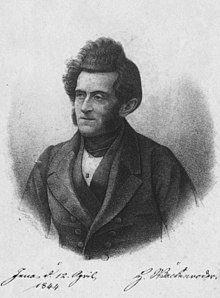Heinrich Wackenroder
Heinrich Wilhelm Ferdinand Wackenroder (born March 8, 1798 in Burgdorf , † September 4, 1854 in Jena ) was a German chemist and pharmacist.
Life
After an apprenticeship as a pharmacist from 1814 to 1819, Wackenroder worked in his father's pharmacy. 1821–1824 and 1825–1826 he studied in Göttingen; for financial reasons he had to interrupt his studies for a year. He completed his dissertation in Göttingen with the chemist Friedrich Stromeyer and received his doctorate in Erlangen in 1827.
Since 1828 he was a professor at the University of Jena and an employee of Johann Wolfgang Döbereiner . They were both regular conversation and letter partners of Johann Wolfgang von Goethe , who was responsible for the chemistry institute he founded and in this function - in consultation with Duke Karl August - also awarded research contracts.
Services
In 1826, Wackenroder isolated the berberine- related plant alkaloid corydalin from the hollow lark's spur (Latin: Corydalis cava ) . Wackenroder was also isolating carotene from carrots during his doctoral thesis . Since the description of his results was not generally published until 1831 after he had become a professor in Jena, 1831 is usually considered to be the year carotene was discovered. Based on the detailed investigations of aqueous solutions of polythionic acids published by Wackenroder in 1846, such solutions are called Wackenroder's liquid . To explain his results, Wackenroder suggested "a new acid of sulfur", pentathionic acid .
From 1838 to 1854 Wackenroder was co-editor of the journal Archiv der Pharmazie of the Pharmacists' Association in Northern Germany. He was also the inspector of pharmacies in the Grand Duchy of Saxony .
Honors
In 1843 he was elected a member of the German Academy of Sciences Leopoldina .
Fonts
- Chemical tables for the analysis of inorganic bodies (1829)
- Synoptic tables on the first-order chemical compounds (1830)
- Mineralogical-chemical contributions to the knowledge of the Thuringian Flötzgebirge (1836)
- Detailed characteristics of the most important nitrogen series of organic acids (1841)
- Chemical Classification of Simple and Compound Solids and the Most Important Compounds of Them (1851)
literature
- Carl Oppenheimer: Wackenroder, Heinrich Wilhelm Ferdinand . In: Allgemeine Deutsche Biographie (ADB). Volume 40, Duncker & Humblot, Leipzig 1896, p. 443 f.
- Wolfram Wendler: Academic teaching in pharmacy around the middle of the 19th century: depicted in the transcript of a lecture by Heinrich Wilhelm Ferdinand Wackenroder from 1845 . Diss. Marburg 2004, online at the University Library of Marburg
- Peter Hallpap: 160th anniversary of death: Heinrich Wilhelm Ferdinand Wackenroder, online on the website of the Friedrich Schiller University Jena .
Web links
- MDR: History of Central Germany ( Memento from January 21, 2003 in the Internet Archive )
- www.erfurt-web.de ( Memento from September 27, 2007 in the Internet Archive )
Individual evidence
- ^ Richard Wolffenstein, Die Pflanzenalkaloide, XVI Corydalisalkaloide, 1. Corydalin, page 337f, preview at Google Books
- ↑ Literary annals of the entire medical science. Edited in association with several scholars by Dr. Justus Friedrich Carl Hecker, Volume 9, Theod. Friedr. Christian. Enslin, Berlin 1827, section VII, wormer means, page 59ff. online at Google Books
- ↑ H. Wackenroder, “About the oleum radicis Dauci aetherum, the carotene, the carotene sugar and the officinellen succus Dauci; as well as about the mannitol, which is formed in the carrot juice by a special kind of fermentation, ”Geiger's Magazin der Pharmazie 33 (1831) 144-172, Ed .: Philipp Lorenz Geiger, Magazin für Pharmacie and the relevant sciences, CF. Winter, Heidelberg 1831, online at Google Books
- ↑ H. Wackenroder, About a new acid of sulfur, Archiv der Pharmazie Volume 97, No. 3 (1846) 272-288, doi : 10.1002 / ardp.18460970303 , online in the Internet Archive
- ↑ H. Wackenroder, Determination of the Oxygen Content of Pentathionic Acid , Archiv der Pharmazie Volume 98, No. 2 (1846), 140–151, doi : 10.1002 / ardp.18460980203 , online at the Bayerische Staatsbibliothek
- ^ List of members Leopoldina, Heinrich Friedrich Wackenroder
| personal data | |
|---|---|
| SURNAME | Wackenroder, Heinrich |
| ALTERNATIVE NAMES | Wackenroder, Heinrich Wilhelm Ferdinand (full name) |
| BRIEF DESCRIPTION | German chemist and pharmacist |
| DATE OF BIRTH | March 8, 1798 |
| PLACE OF BIRTH | Burgdorf |
| DATE OF DEATH | September 4, 1854 |
| Place of death | Jena |
